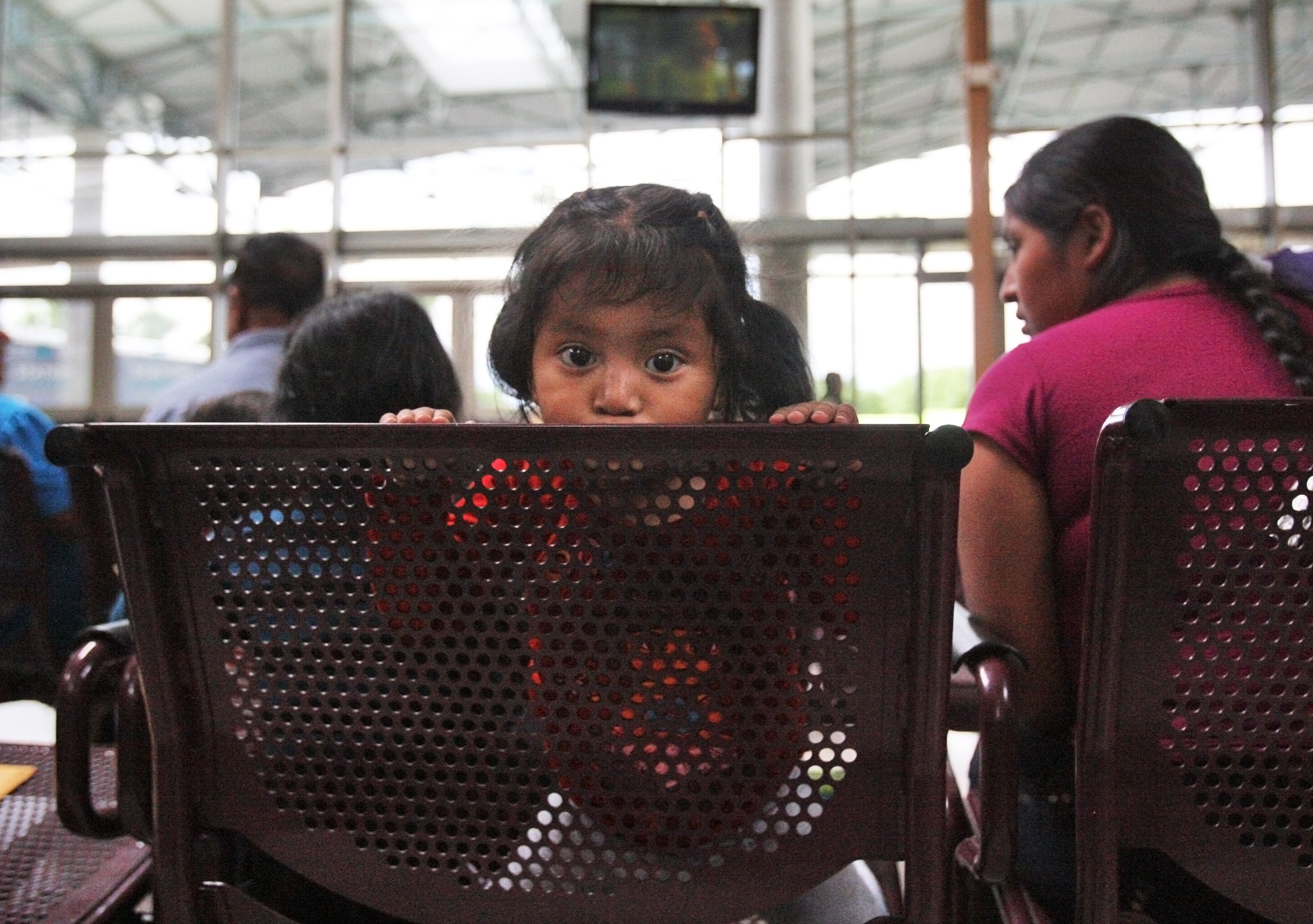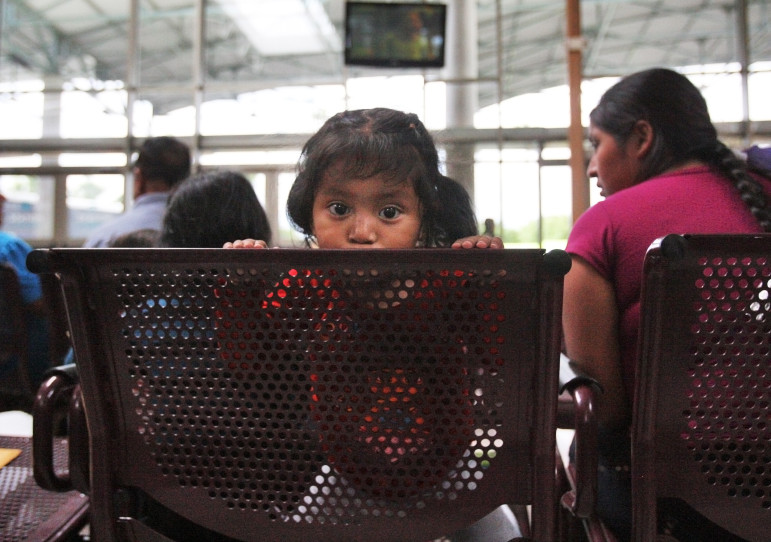
Joel Martinez / McAllen
Gaby Daina, of Gutamala, waits with her mother at the McAllen bus station for their bus to take them farther north.
MISSION, Texas — A group of Honduran immigrants who had crossed into the United States illegally frantically waved down a deputy constable’s Chevy Tahoe as it approached them on a dirt road a couple hundred yards from the Rio Grande about 10 p.m. one Wednesday in early August.
The deputy parked the SUV a few dozen feet from the group — a 16-year-old girl, 12-year-old boy and a 20-something mother and her small child. The teenager broke away from the group and hurried toward the Tahoe’s backseat, sobbing.
“Agua,” she cried. “Water!”
***
Nearly 63,000 unaccompanied children — mostly from Honduras, Guatemala and El Salvador — crossed into the United States between Oct. 1 and July 31 without prior permission, according to government data released early in August. Another nearly 63,000 people crossed with family members. The numbers represent an increase of nearly triple over the same period last year.
Under federal law, children from countries other than Mexico and Canada, and any family members traveling with them, are allowed to stay in the country temporarily until an immigration judge can assign them a more permanent status.
Central American immigrants overwhelmed federal authorities on the border earlier this summer, as Border Patrol and other immigration enforcement agents could not quickly enough process them and move them on to their destination cities — Atlanta, Baltimore, Chicago, D.C., Los Angeles, New York — across the U.S. interior.
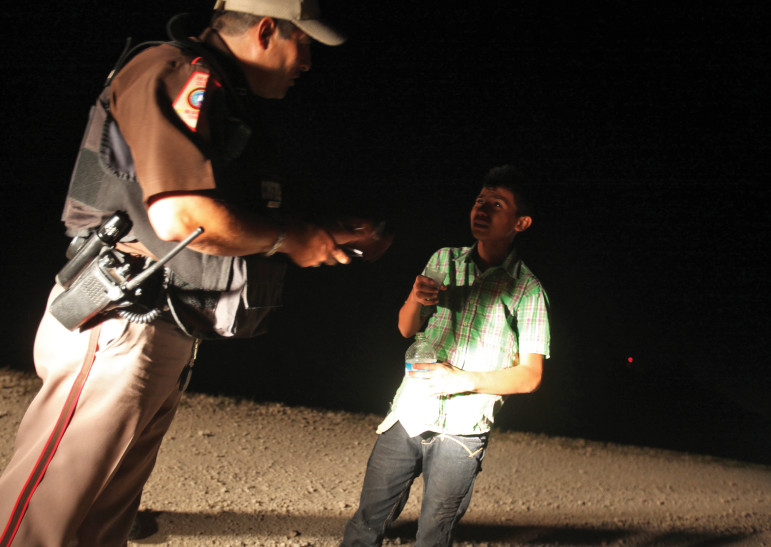
Joel Martinez / McAllen
A Hidalgo county constable gives water to a boy crossing the border with two other immigrants as they wait for the US Border Patrol to arrive in August near Granjeno.
The Department of Homeland Security, the federal department that oversees Border Patrol and other immigration enforcement agencies, turns children traveling alone over to the Department of Health and Human Services, which set up large makeshift shelters at military bases. After they’re apprehended, the unaccompanied children have virtually no contact with the public until they’re released into the care of a family member or, sometimes, a foster family.
But those traveling in family units are released to their own devices.
After completing their processing paperwork, authorities drop the families off en masse at local bus stations to catch rides out of town. The sheer volume they were dropping off at the McAllen, Texas, bus station created a “humanitarian crisis,” as travelers — weary, sometime ill and often wearing the same clothes in which they crossed the Rio Grande — crowded the facility. Sometimes unable to get a bus out of town the same day as they arrived, they slept on the floor of the station’s lobby.
A couple of local women, noticing this scene one night in June, notified Sister Norma Pimentel of Catholic Charities of the Rio Grande Valley. Pimentel, in turn, convinced Sacred Heart Church, blocks away from the bus station in downtown McAllen, to open its parish hall as a “respite center” for the immigrant families.
The center opened on June 10, and soon gathered more donations of food, clothing and toys than they could store. The city and county governments pitched in with air-conditioned tents, portable showers and other resources.
***
“Welcome,” the deputy said to the teenage girl in Spanish, trying to comfort her. “You are in the United States. Nothing is going to happen.”
Under his breath, he wondered in English if giving the ice water from his personal jug would actually harm the disheveled immigrants.
“It’s cold as [expletive]. I wonder if it’s going to get them sick,” he said. “Nah, I don’t think it will.”
He poured water from the jug into small, collapsible cups. The two youths gulped down their shares and asked for more.
Between cries, the group explained they didn’t know each other, but had crossed the river together earlier that day.
“No, it’s just us three and the baby,” the boy said in Spanish, when the deputy asked if anyone else was with them.
They left their homes about a month before, he said. He was headed to North Carolina, while the teen said she going to Maryland, and the young mother to New York.
***
The roots of the migration remain unclear, further muddied by political partisans. But this much is relatively undisputed: The Central American countries most affected are some of the most dangerous. The murder rate in Honduras was the highest in the world — 90.4 per 100,000 in 2012, the last year for which data is available — according to a United Nations report. El Salvador and Guatemala ranked fourth and fifth.
Anne Cass, a local immigrant activist whose work has spanned more than three decades, said she was inspired to get involved on behalf of immigrants because of the lessons her World War II-veteran father taught her.
“Having seen my father’s photos of the concentration camps, I did not understand how our country could be so calloused,” she said about her decision during an immigration spike in the 1980s to champion the rights of migrants who fled to the United States seeking asylum. “I didn’t ever want my kids to read about in history that we refused to grant amnesty to these refugees.”
“If you listen to the stories, you can’t turn your back on these kids,” said Amanda Posson, a grant administrator with Refugee Services of Texas (RST).
“They’re fleeing rape and extreme violence,” she said.
RST, a nonprofit based in North Texas, but with offices across the state, provides “post-release services” to children after they’re released from shelters run by Office of Refugee Resettlement (ORR), a branch of Health and Human Services. RST workers offer counseling, legal aid and other services to children who ORR has determined have been traumatized.
(A spokesman for the office that oversees ORR declined an interview request for this story.) Under ORR’s screening process, only about 10 percent of kids qualify. When told some are surprised by the low percentage, Posson said “So are we.”
“These routes are very dangerous, especially if they’re coming on La Bestia, the train,” Posson said, referencing the notorious freight train — nicknamed “The Beast” — that Central Americans often jump onto and ride from southern Mexico to near the Rio Grande.
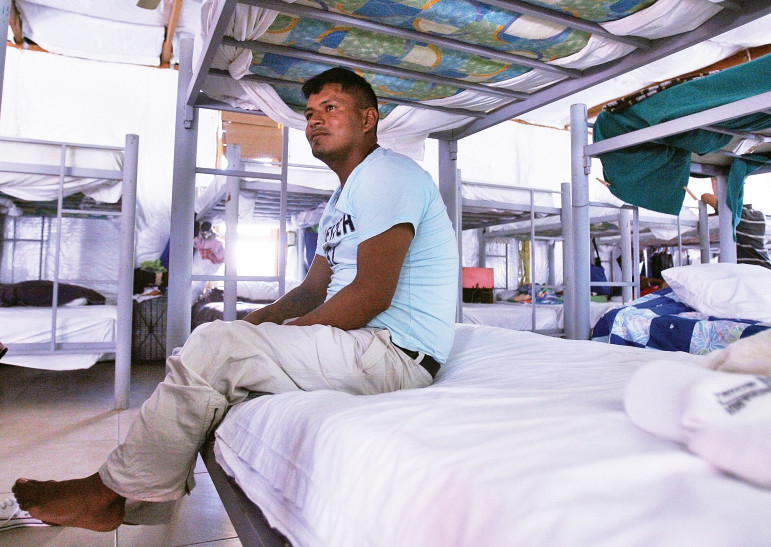
Joel Martinez / McAllen
Oscar Antonio Lopez Carbajar, immigrant from Honduras, rests in the mens dormitory at the Senda de Vida August 13, 2014 in Reynosa, Mexico.
“Everywhere in Mexico, there are bands of thieves. Some are more dangerous than others. Some only steal your money, or for example, some will take even your shoes,” said Oscar Antonio Lopez Carbajar, a 28-year-old Honduran man, who had travelled on La Bestia. He spoke, in Spanish, from his bunkbed in a dormitory of the Senda de Vida Shelter on the Mexican side of the Rio Grande, where he’d been staying for about a month.
Volunteers and professionals who have worked directly with the Central American families can relate horror stories they’ve heard from the trail.
Hermi Forshage has volunteered at Sacred Heart since mid-June. As an intake worker, she greets families when they arrive at the shelter, records their information, and helps them navigate through their next steps.
“I sit there and I laugh with them and I cry with them,” she said. “I tell them that nobody is allowed to cry alone.”
I asked her if she’d found any story she’d heard particularly powerful.
One Honduran man came to the shelter with his 15-year-old son, Forshage began, her voice already breaking.
The pair hired a smuggler to lead them to the U.S. for a few thousand dollars, but he pocketed the money and abandoned them at the beginning of their journey in a Guatemala hotel room, she said. Weeks later, they were kidnapped in Tampico, Mexico. Their captors held them for ransom, demanding they call relatives to send money.
“‘One day they put the gun to my son’s head,’” Forshage recalls the man saying. “‘I don’t know if it was the hand of God, or they were just trying to scare us,’ he says. But the gun didn’t go off, because he says they pulled the trigger.”
The effects from that episode lingered to their time in McAllen.
“I mean, his son was traumatized,” Forshage continued. “You could tell, that his son was just traumatized. The kid was just, he was just sitting there. And he didn’t cry, he didn’t talk, just nothing. He just sat there … the whole time just looking down. And his dad the whole time was just crying and telling me the story.”
Forshage paused to recall that tears were running down her own face as she listened to the story.
“And he said there were young girls in that group that they had kidnapped,” she continued. “He said they would come and pull the young girls away.” He says, ‘We knew that they were being raped. We could hear them screaming in another room.’ He said: ‘But we couldn’t do anything about it. We were so helpless that we couldn’t do anything about it.’”
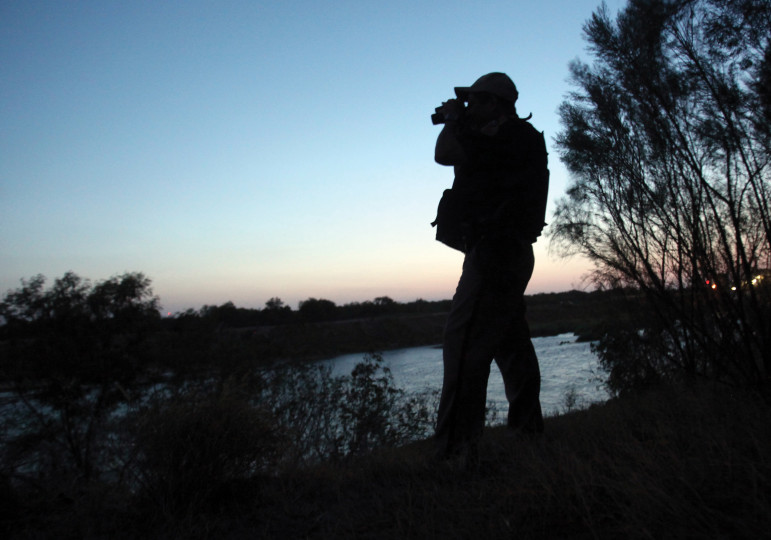
Joel Martinez / McAllen
A Hidalgo county constable patrols hear the banks of the Rio Grande River at Anzalduas Park.
The deputy constable didn’t allow the group of young Hondurans in his Tahoe, even though they seemed to expect him to take them in the vehicle.
He didn’t know what kind of diseases they might carry, he said. At some point after the agent took the travelers away from the dirt road, they’d be separated. The two single youths would be funneled into a group with other unaccompanied minors, and the mother would be assigned to a group of other parents traveling with their kids.
But their journey won’t stop there.
Authorities will work to unite the minors with relatives already living in the United States.
If the mother also has a destination she plans to reach, she’ll be given a legal document known as a “notice to appear” in immigration court at a later date. Then, Border Patrol agents will drop her and her child at the McAllen bus station, where they’ll likely be met by a Catholic Charities volunteer, who will lead the pair to Sacred Heart.
***
As they wait for their trips out of town at the McAllen bus station, mothers chat with each other in Spanish as small children suck on bottles and older ones play.
A boy celebrated his 10th birthday at Sacred Heart with vanilla cupcakes and bilingual renditions of Happy Birthday, said Sarita Fritzler, the team leader for Save the Children’s emergency response team in the Rio Grande Valley. Under Fritzler, the organization has set up a “child-friendly space” in the corner of the church’s parish hall.
But the normal scenes of kids being kids belie the horrors some have seen in their home countries and on their journeys north.
Under federal law, immigration officials are supposed to process unaccompanied children and release them to HHS in less than 72 hours, but at the peak of the summer’s surge — when hundreds of Central Americans were crossing the border daily — authorities were having trouble making that deadline. The children were sometimes kept in crowded, cold cells for four or five days.
“The heladeras, ‘the iceboxes,’ as the kids call them, are kept at 55 degrees,” Posson added. “Being a child lost and alone in a 55-degree holding tank, is that really how we want to treat children?”
And the network of non-profit workers offering social services is largely unavailable to the unaccompanied children, despite Fritzler’s efforts.
“We’ve been advocating since we got here that — you know, these are children who have mother or caregiver with them,” she said, referring to the children she meets at Sacred Heart. “And the ones who are most in need are the unaccompanied children. But because they are held in Border Patrol custody and then released to HHS, we’ve not been able to have that access to provide the programming, even though we knew that they’ve spent anywhere from three to five days to longer in the processing sites of Border Patrol, and that they have limited capacity to do anything.”
This story appears in the upcoming September/October issue of Youth Today.
Jacob Fischler is a staff writer with The Monitor newspaper in McAllen, Texas. He covers Hidalgo County and legislative affairs for the paper. You can reach him at jfischler@themonitor.com or on Twitter: @fischlerRGV.


